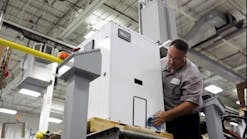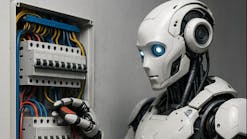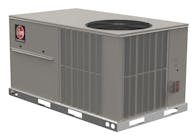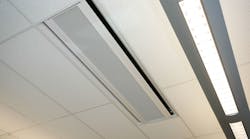Common in other parts of the world, chilled beams have yet to see widespread use in the United States. For the uninitiated, this article explains the fundamentals of chilled beams and how they save energy.
Water > Air (for Energy Savings, at Least)
Water has a greater volumetric heat capacity than air, requiring 1/3,440 the volume to pump the same amount of energy at the same temperature difference. Chilled beams take advantage of water’s increased heat capacity, using only 1/7 of the energy it would take to pump air through a standard HVAC system.
Cooling Components: Which to Minimize, Which to Maximize
An active chilled beam has two distinct cooling components—induced room air and primary air—with the goal to maximize induced air, which is cooled by the chilled-water coil. To start, primary air is discharged into chilled beams through nozzles (Note: Induced-air amount is affected by inlet pressure and nozzle size. Typically, the smaller the nozzle, the greater the induction rate.) Low-pressure zones are created around them as primary air expands and exits the nozzles. After these low-pressure zones induce the air from the room over the chilled-water coil, the coil cools the air and provides sensible cooling. This sequence must be maximized to take full advantage of both the pumping efficiency and the heat capacity. In other words, the higher the air induction rate, the greater the savings.
On the other hand, primary air must be minimized to achieve the greatest energy savings possible. This can be difficult because primary air satisfies three requirements in a chilled-air system: ventilated air, latent capacity, and the needed energy to operate chilled beams.
The first of the requirements, ventilation, will not set airflow. According to ANSI/ASHRAE Standard 62.1, Ventilation for Acceptable Indoor Air Quality, minimum airflow will not provide adequate latent capacity to meet design loads at standard commercial air temperature. However, there always are exceptions, so design should be assessed on every project.
The second requirement, latent airflow, generally dictates airflow. The system provides less primary air by depressing the humidity level of the primary air, increasing the latent capacity of airflow. Ideally, the primary air system will depress the specific humidity so it is at a level at which the required primary airflow and the ventilation requirements are equal. The goal is to balance the space’s needs with the minimum primary air and distribution energy.
Lastly, while primary air is responsible for the energy needed to operate chilled beams, reducing its flow is a way to decrease reheat energy. When the energy efficiency of a system is minimized, a chilled beam’s chilled-water system will control the majority of the cooling load. The control is not stagnant; rather, it is able to change as the room load changes, and the chilled beam’s chilled water can be adjusted or shut off to customize room cooling. However, the latent capacity of the room will not change because of the depressed specific humidity level and continuous supply of primary air. This helps to maintain comfort even at low sensible-load times without the need for reheat to maintain temperature or humidity. And on the whole, a reduced need to reheat and distribute energy helps chilled beams improve energy efficiency within a building design.
Energy Savings 101: In Review
Chilled beams can be valuable additions to HVAC systems designed to not just meet basic code requirements, but achieve greater energy efficiency. They provide multiple ways of doing that, whether it is through reducing primary air, utilizing the heat capacity of water, or decreasing the need to reheat and distribute energy. Understanding how they operate and can reduce costs is the initial step to take in determining whether they are right for your project.
Ken Loudermilk is senior chief engineer of marketing and sales for chilled beams and underfloor distribution products for Titus. With more than 35 years of experience in commercial HVAC, he specializes in educational, health-care, and LEED facilities. He is a member of a number of professional organizations and has held numerous leadership positions, including chairman of ASHRAE Technical Committee 5.3, Room Air Distribution.









